For Nick Cushing’s final match in charge of Manchester City Women, he had the small task of getting the better of defending champions Arsenal Women. This top of the table clash promised to have a major factor in the race this campaign, and it did not disappoint in its intensity level. Entering this match, Manchester City Women and Arsenal Women led the league with 33 points apiece, with City holding a two-better goal difference.
This tactical analysis will look at the key areas of the match as City gave Cushing the dream send-off by defeating Arsenal 2-1 on the day. Arsenal dominated possession for the majority of the match but were unable to consistently create opportunities against City’s stubborn defensive tactics. This analysis will also examine City’s attacking methods.
Lineups
For the home side, it was the exact lineup you would have anticipated. At right-back, Georgia Stanway continued to fill in for Janine Beckie as she is away on international duty. Jill Scott acted as a central midfield/right midfielder hybrid for Cushing, depending on situations during the match. Up top, Pauline Bremer accompanied Ellen White to try and break down Arsenal’s defence and also cause problems when out of possession.
For Arsenal Women, their side was changed a fair bit from the one that lost to Chelsea Women last time out. Their midfield consisted of Jill Roord, Jordan Nobbs, and Danielle van de Donk. Most often, Nobbs played the most advanced role of the three. Out wide, Lisa Evans played opposite of Bethany Mead. Leonie Maier was also brought in at right-back, which moved Viktoria Schnaderbeck to centre-half alongside Leah Williamson.
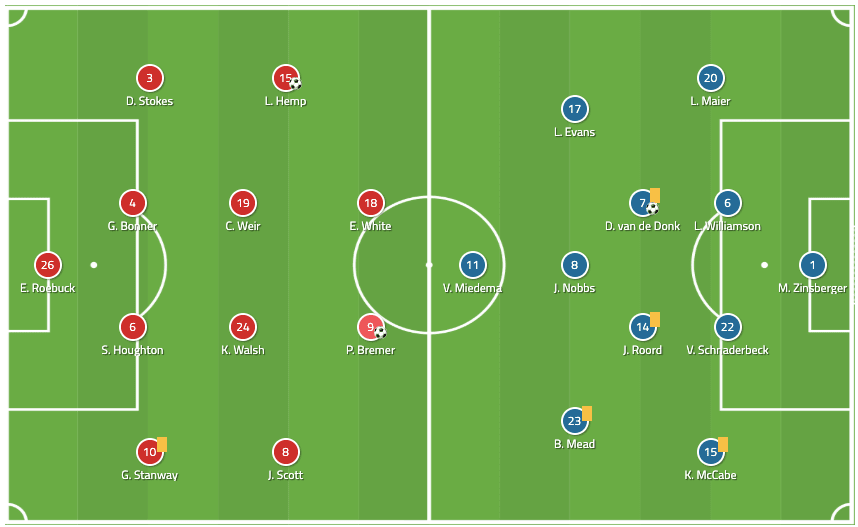
Manchester City Women’s pressing structure
While being the home side, Cushing would have been well aware of Arsenal Women’s intentions to possess the ball for large periods of this match. He set his side up defensively to deal with this accordingly. When out of possession, Manchester City Women dropped into a 4-4-2 formation. Scott moved out wide into the right-midfield position and Hemp dropped in deeper on the left, leaving Walsh and Weir to cover the central space. The most important part of this structure, however, was the two strikers.
The two banks of four when defending were instructed to hold a deep block. This restricted the space afforded to Arsenal’s danger players such as Miedema, van de Donk, and Mead. However, sitting too deep against Arsenal is equally as dangerous as playing too aggressively.
To avoid this, White and Bremer were tasked with being extremely active. They consistently worked in tandem to press the ball and the nearest passing option, never allowing Arsenal Women to be completely comfortable in their initial build-up. This was very effective as it did not give Arsenal a chance to set their attacks up consistently.
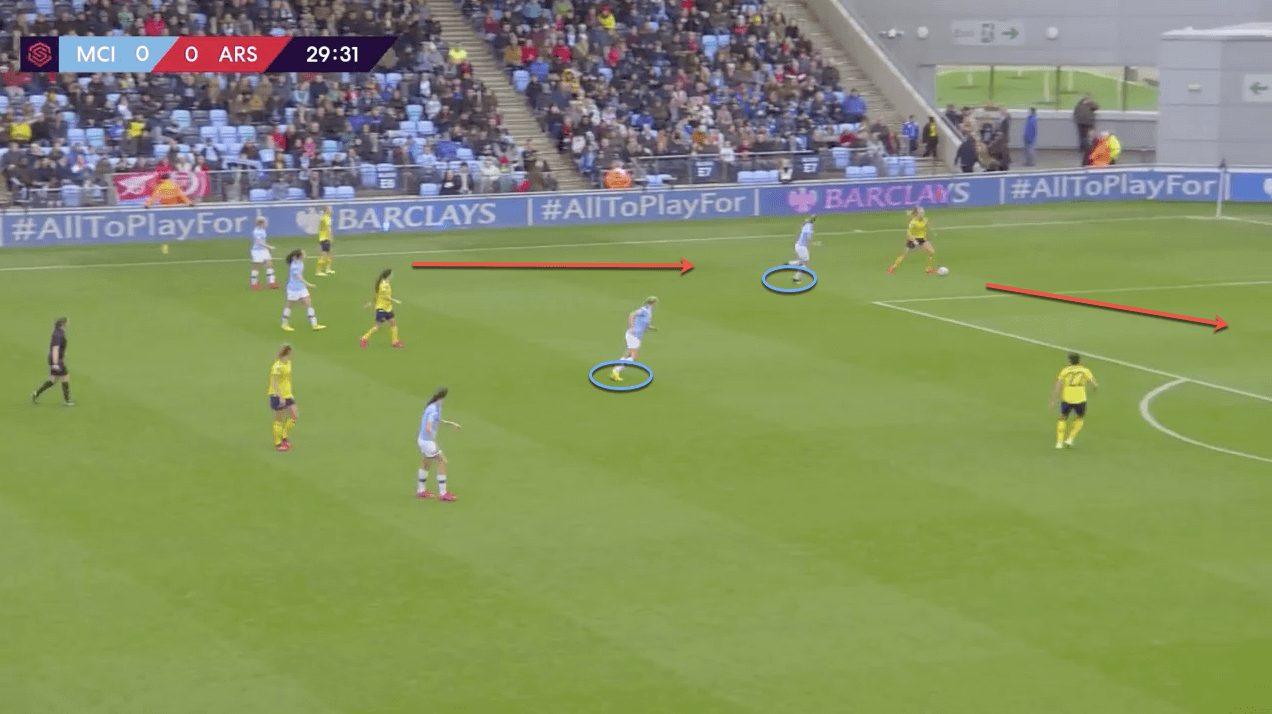
In the image above, you can see an example of Arsenal Women regaining possession and looking to recycle it around their backline and to the opposite side of the pitch. As the pass is played backwards, White jumps into her pressing instructions and rushes the centre-back into playing a pass back into Manuela Zinsberger. White continues her press on the ball as possession reaches the goalkeeper, however.
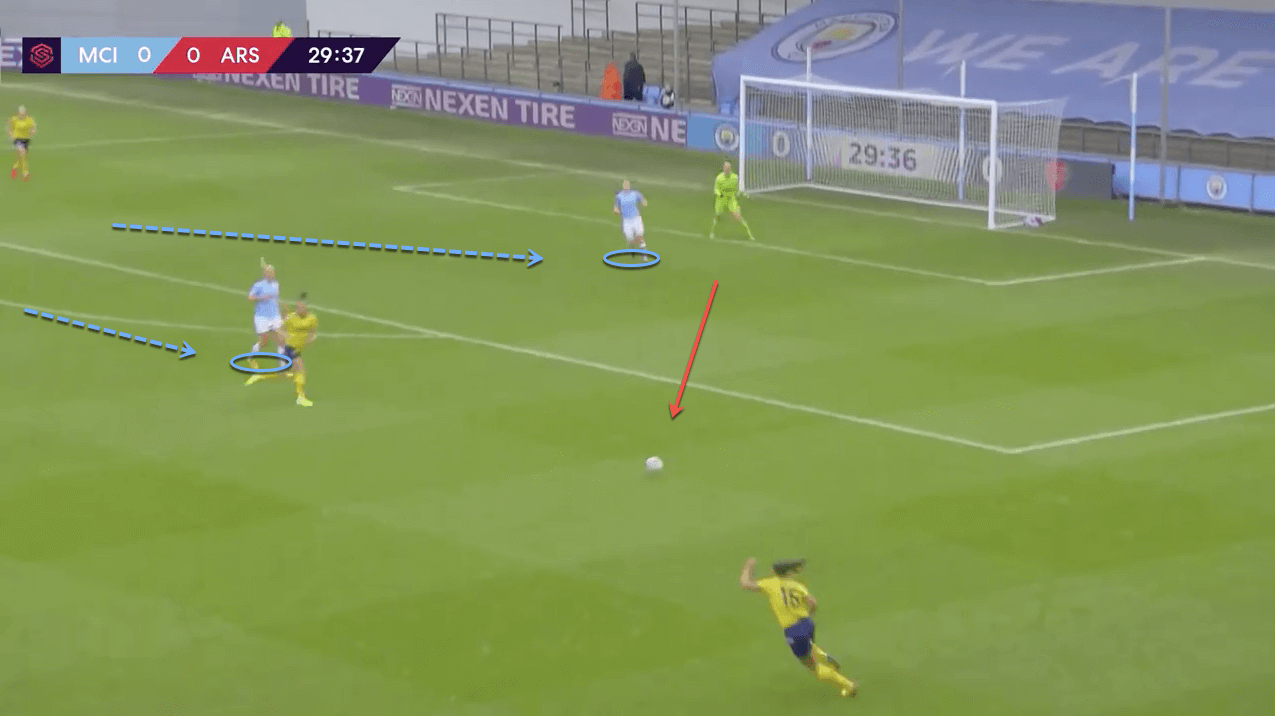
Behind her, Bremer’s task is to take away the nearest passing option. As the pass is received by Zinsberger, the German forward moves to restrict the central passing option available. With this pass being taken away, and White’s urgent press closing down on the keeper, she makes a rushed pass out wide into Katie McCabe. It is off-target and City are able to win possession back.
Overall, City were very willing to allow the away side to keep possession with their defenders. Their passes per defensive actions (PPDA) for this match was 16.19, which is much greater than their season average. As we will discuss in the section below, Cushing set his side up very well to deal with Arsenal’s attacking threat, and keep them at bay for large portions of the match.
Arsenal Women’s disconnect
For the majority of Sunday’s match, Arsenal Women found it extremely difficult to find any success in the final third. This was in part down to Manchester City Women’s defensive structure. As we mentioned in the section above, their deep set-up with the two banks of four behind the strikers who looked to press aggressively left little room for Arsenal’s danger players to create opportunities.
The key to this tactic was City’s focus on limiting the space in between their defensive and midfield lines. With this emphasis, it caused Arsenal’s creative players to need to look for other areas to receive possession. This was a massive influence in like likes of van de Donk and Nobbs dropping into deep positions to receive passes and look to distribute. However, they did this at the expense of leaving Miedema too isolated up front, and due to this, she was unable to have any kind of impact on the match. In the pass map that you can see below, this frustration is clearly illustrated. Arsenal’s defenders and deep midfielders have all created strong passing links between one another, but as you look at the attacking players, the passing links here are much more scarce.
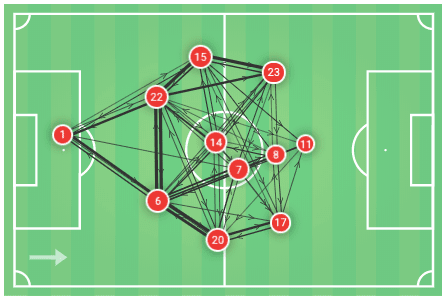
City’s energetic defending can be a big factor as to why this disconnect between the initial build-up structure for Arsenal and their attacking players was so big. In the image below, we can see a situation where Mead has possession and comes inside to look for support options. She is able to find van de Donk in the centre of the pitch and makes the pass into her Dutch teammate.
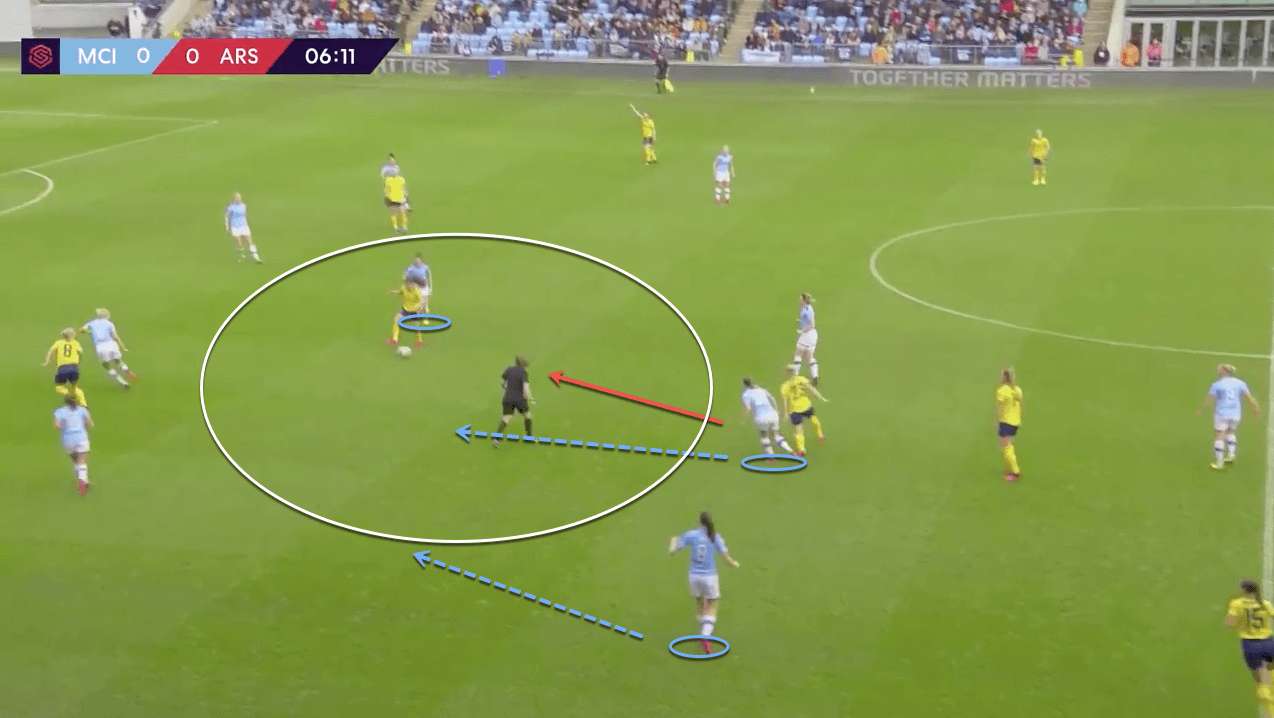
As soon as the Arsenal playmaker receives possession in this area behind Manchester City Women’s midfield line, they react extremely quickly. Her marker holds van de Donk up, as the rest of the midfield drop into position. As you can see in the next image below, City has forced van de Donk backwards and have three players behind directly behind the ball. This forces Arsenal’s number seven to pass back to her centre-half, and for Arsenal to reset their attack and look for a different avenue through City’s defensive block.
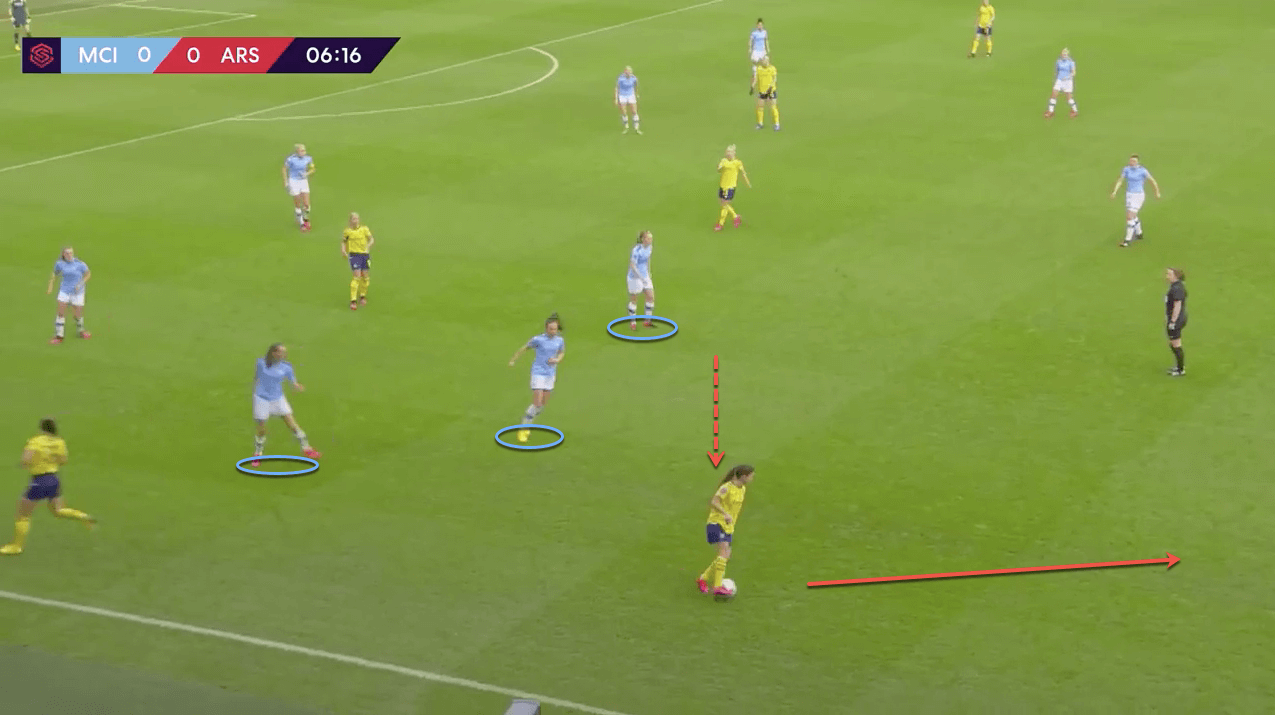
Van de Donk’s deep positioning made life difficult for Arsenal Women when it came to creating chances. The Dutch international is much more effective working close to her compatriot Miedema. A tactic used earlier this season by Montemurro has seen the playmaker occupy a secondary striker role right next to Miedema. This set-up was a key component in the side’s win over Tottenham Hotspur Women earlier this season. A similar alteration could have made the difference in this match as well. In one of the only situations where van de Donk moved into the front line in attack, she made a brilliantly timed run to be on hand to smash in a rebound from Miedema’s initial strike to bring the score back to 2-1.
Attacking focus shift for City
In the beginning stages of this match, Manchester City Women struggled to break down their London opponents. When Montemurro’s side was out of possession, they dropped into a midfield five with Miedema ahead of them leading the press. This has multiple looks depending on the player in possession for City, but for the most part, Arsenal’s midfield presented an impenetrable line five wide.
Using this, Arsenal kept Manchester City and their key initial build-up personnel ahead of them. As you can see in the image below, the double pivot of Walsh and Weir are sitting in between their defensive line and Arsenal’s midfield line. They offer an option to the centre-halves behind Miedema, but once possession came to them in this area, they had a lack of forward options. Until about 25 minutes into the match, City were unable to create any attacking opportunity of note due to this tactic from the away side.
Before the match, I wrote a preview of what to expect in this massive match. One part focused on the recent success from Manchester City Women in playing passes from deep positions over the top into the paths of the likes of White and Bremer who look to make runs in behind and into the channels. On Sunday, this turned out to be a major focus point in Cushing’s attacking tactics.
While this tactic was not consistently effective, it presented City with their only way of breaking through Arsenal’s defensive structure. When midfielders Walsh and Weir received possession, they looked to play long passes into the channels between the Arsenal centre-halves and full-backs for White and Bremer to run onto. From here, they would look to hold up possession and wait for players to arrive in support, often in the form of teammates making runs into the box for crosses.
When City entered the final third through possession-based passing movements, they often looked to move this possession wide and look to get crosses into the box as well. With White and Bremer up top along with Hemp and her tendencies to move into central positions, they had plenty of options to look for in this area.
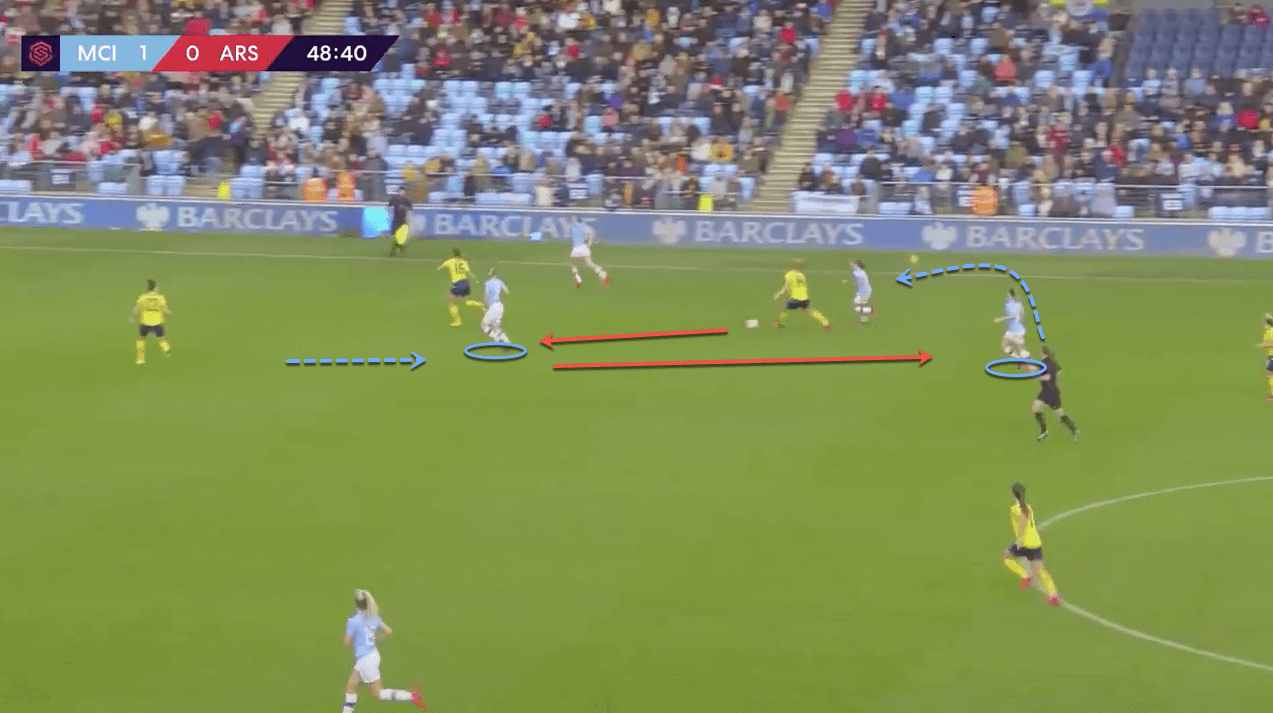
Above, you can see Stanway in possession as City progress the play in the lead-up to their second goal. As she moves forward, White drops in to show for support and is found by her teammate. She is quick thinking and lays it directly off into the path of Walsh, who moves wide into the space left vacant by Stanway’s central run which has dragged the defender in along with her.
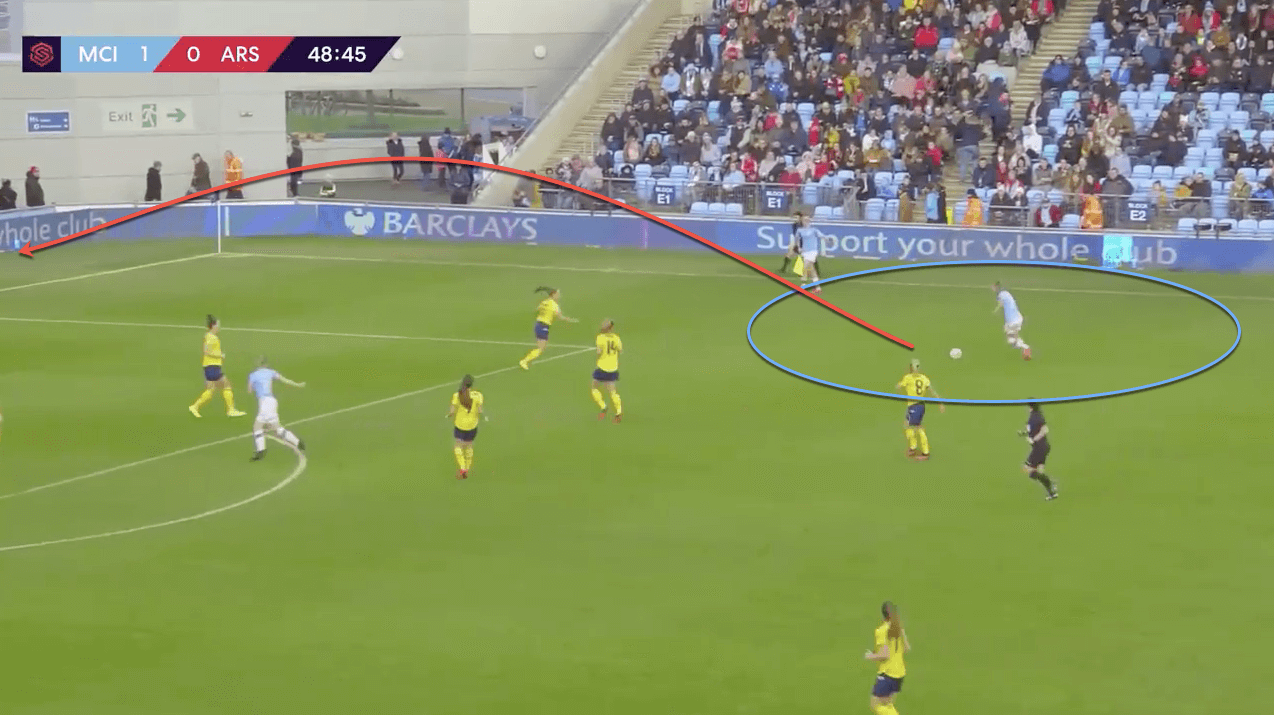
Walsh is left completely unmarked and has all the time she could ask for to deliver a cross into the box. By now, City have sent three players into this area, and the English international picks out a ball to the back post where Hemp is able to guide a looping header back across goal, leaving Zinsberger rooted where she stands.
City’s midfield pivot
In a match where City needed to be defensively resolute to come away with all three points, the midfield was required to protect their backline efficiently. Weir and Walsh provided this brilliantly on Sunday. Between the two of them, they were successful in 12 of their 15 defensive duels. In addition, they always provided outlets for their teammates when possession was regained in their defensive third, allowing the home side time to regroup and look to initiate an attack of their own.
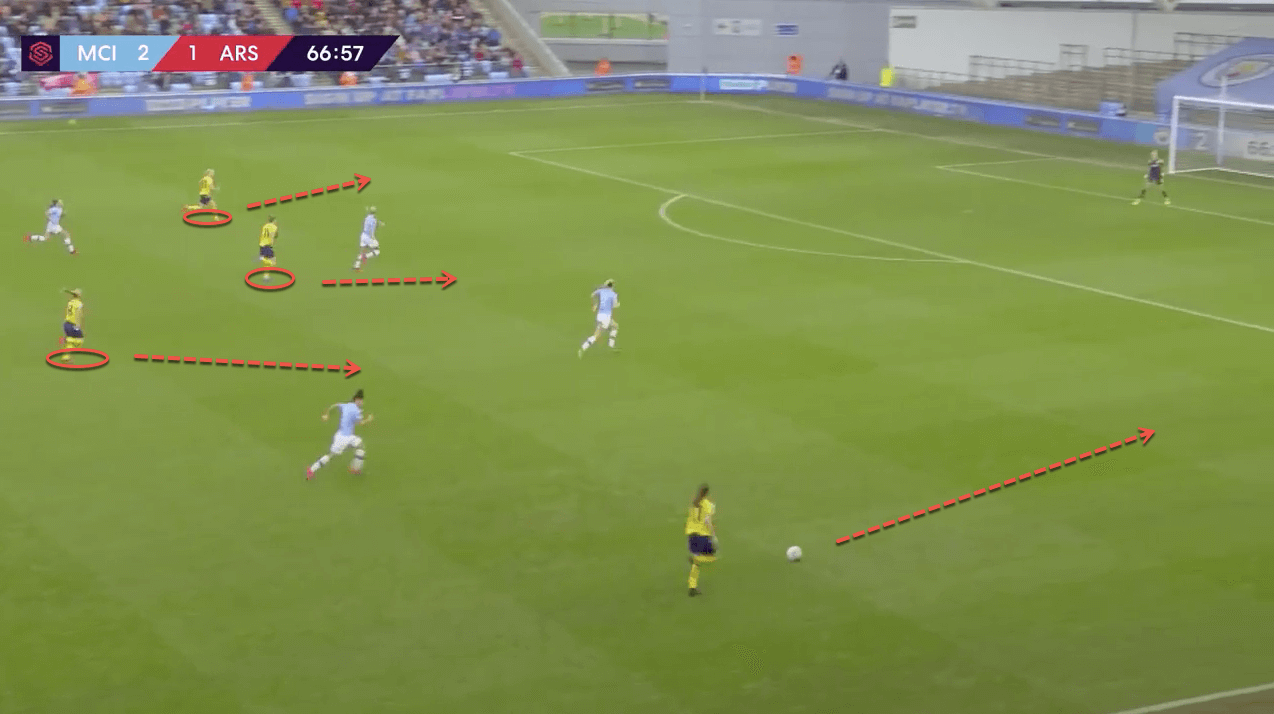
In the image above, you can see Arsenal in an opportunity to get forward with numbers, with City having committed players forward themselves in the attack before. As possession is worked down the line, the home side attempt to regain shape and mark the Arsenal players making runs into the box for the counter-attack.
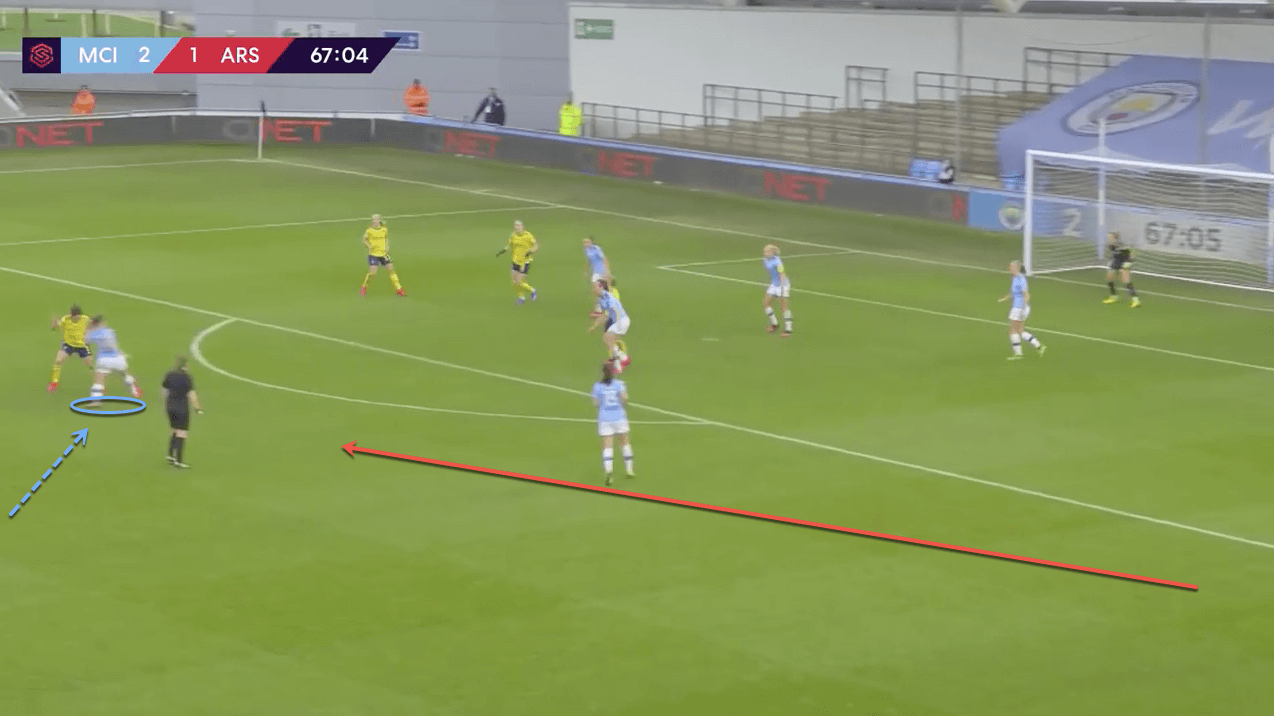
Arsenal attempt to play into the player arriving at the edge of the box. However, in Walsh’s recovery run, she has read the play perfectly and gets back in time to cut out the pass and stop the danger before it had a chance to really begin. Her and Weir consistently made timely interventions such as this that allowed City to keep Arsenal at bay and secure the massive three points.
Conclusion
In the end, Manchester City Women’s 2-1 victory represented the perfect send-off for Cushing. Their manager will be missed, but there is no time for reflection, as City find themselves controlling their own destiny in the race for the 2019/20 FAWSL title. With Chelsea Women coming to Manchester on the 23rd of this month, Houghton and her side know exactly what they have to do to accomplish their goal for this campaign.
For Arsenal Women, consecutive league defeats to each of their title rivals leave their hopes to repeat in a dier state. However, they know that their remaining schedule leaves very little potential hiccups, and will be watching the City vs Chelsea encounter with particular interest. As well, they will be looking to boost their form and morale going into next months Champions League tie against Paris-Saint Germain, who have impressed so far this season.





Comments